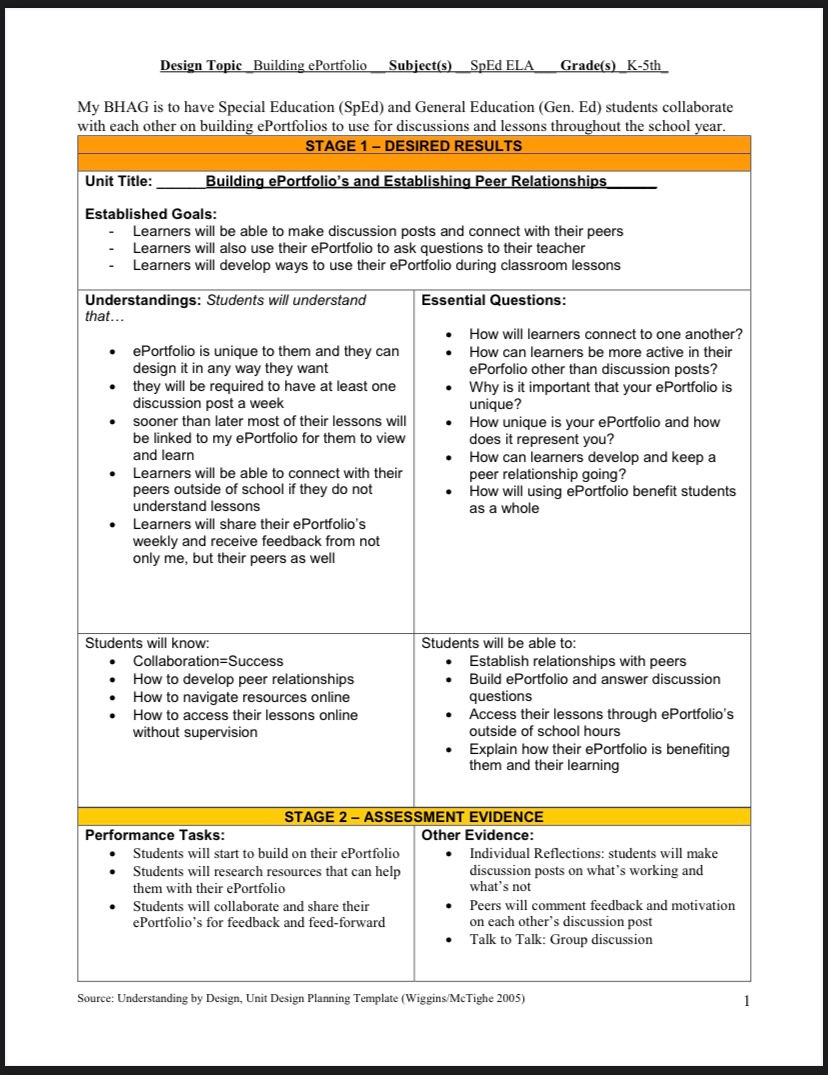Understanding by Design
Working on lesson plans based on my innovation plan has helped me expand more on what my students need to be successful. Wiggins and McTighe’s (2005) Understand by Design (UbD) template is subject to give very more details on a lesson than Fink’s 3-column table. Because of its granular structure, UbD’s template is more effective for designing smaller units of instruction with much greater detail. The UbD template is divided into three stages: (1) Identify desired results, (2) Determine acceptable evidence, and (3) Plan learning experiences and instruction (Wiggins & McTighe, 2005. p.18). This design process adds to my Innovation Plan by proving I am not just giving a bunch of students Chromebooks and letting them free. This design goes into detail about how students will develop better relationships, access lessons through ePortfolios, and be able to connect with their peers outside of school.


The learning plan above utilizes WHERETO acronym by Wiggins and McTighe’s (2005) that highlights the key elements that will be implemented for instructional planning.
W = Inform students about Where the lesson is going, What will be expected, and helps the teacher know Where the students are coming from?
H = Hook all students and Hold their interest?
E = Equip students, help them Experience the key ideas, and Explore the issues.
R = Provide opportunities to Rethink and Revise their understanding and work?
E = Allow students to Evaluate their work and its implications?T = Be Tailored to the different needs, interests, and abilities of learners?
O = Be Organized to maximize initial and sustained engagement as well as active learning
Evaluation of 3 Column Table and UbD Template
I will admit that having Fink’s 3-column table to go off of helped me dig deeper into my lesson plan and create the UbD plan for my students. To first use Fink’s 3-column table, allowed me to see and think about the bigger picture. What I really want this lesson to be about, how this will benefit the students, and what is the purpose of it. UbD template allows you to think from a student's point of view. It allows us to think of how to keep students engaged and motivated, some questions they might have, what skills will the students learn while building and exploring ePortfolios, etc. I will continue to use both Fink’s 3-column table and Wiggins & McTighe UbD template to make lesson plans for my students.
References
Fink, L. Dee, PhD. (2003). A self-directed guide to designing courses for significant learning. [PDF file].1-37. Retrieved from: https://luonline.blackboard.com/bbcswebdav/pid-3863516-dt-content-rid-59401589_1/xid-59401589_1
Rhythm Systems. (2022). Complete Guide to Big Hairy Audacious Goals (BHAG). Rhythm Systems. Retrieved October 3, 2022, from https://www.rhythmsystems.com/bhag-big-hairy-audacious-goal
Wiggins, G., & McTighe, J. (2005) Understanding by design (2nd ed.). Alexandria, VA: Association for Supervision and Curriculum Development ASCD